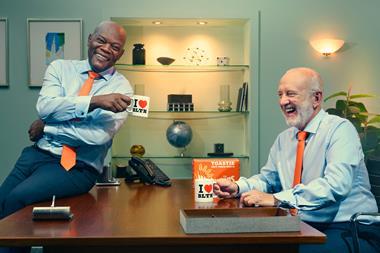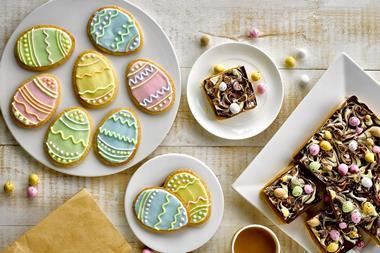Creating an eye-catching display for wrapped breads in-store takes some skill and forethought. But there are plenty of techniques at retailers’ disposal
Let’s face it: the wrapped bread aisle in a supermarket is rarely the most exciting or appealing part of a store.
While the in-store bakery area is typically sited separately for a welcoming ‘store within a store’ feel, and may feature attractive touches such as wicker baskets and tables laden with freshly baked goods, the wrapped bread fixture can appear to have been forgotten.
Any retail aisle needs to be engaging, and that’s particularly the case when the shopping mission is as routine as wrapped bread, where customers are likely to purchase the same loaf week in, week out, without giving it a lot of thought. Methods as simple as in-store signage can create a more engaging store environment – whether advertising discounts and special offers, or offering images of products to get taste-buds tingling.
And there are a few indications that retailers are making moves to improve the situation – as a recent walk around major grocery multiples shows.
In the Sainsbury’s store we visited, the retailer was using standard shelving with multiple facings of best sellers. The shelves were broken up with vertical signage showing a new Kingsmill loaf.
Meanwhile, Tesco had adopted the plastic crate approach with wheels on the lowest-level units for easy manoeuvrability – practical, but not particularly attractive. What was more appealing were black header boards above the shelves with pictures of beans on toast and the message ‘Best buddies with baked beans’ and another highlighting cheese on toast with the message ‘Get the grill on’.
At Asda, black shelving showed off the brightly coloured packaging well, and there was hanging signage depicting croissants as well as a sign promoting Asda’s Extra Special wholemeal & rye farmhouse loaf at 85p.
Freshly baked goods
Another marketing trick – one of the oldest in the book and employed by house sellers as enthusiastically as bread sellers – is using the smell of freshly baked goods. This draws customers into that area of the store and gets them thinking about what bakery products they’re in the mood for – whether wrapped or otherwise, suggests Chris Peach, head of packaging and design at Marketing Sciences Unlimited. He adds that sampling is also a valuable tool.
“As buying bread is so habitual for many, the introduction of staff promoting products in the aisle will get customers engaging with the product,” he says. “Free samples of white, wholemeal and seeded breads will get customers experiencing items that they might never usually consider.”
In other sections of the supermarket, Peach says brands are creating their own shelving or displays to put on the existing shelves. “This is most often done by premium brands, who want to make their products look upmarket and stand out from the crowd by creating an eye-catching display.”
It’s an approach favoured by Allied Bakeries, which has developed strategies designed to reignite consumer interest in wrapped bread (see the company’s artist impression on p43). “We recommend to retailers that they improve in-store visibility of premium bread by merchandising brands together, placing brands like Allinson’s on a higher shelf, rather than in baskets,” says Zoe Taphouse, category director at Allied. “We also suggest smaller loaves are merchandised with parent products, to increase awareness of the options available.”
Taphouse says Allied is working with a number of retailers to help develop a retail environment that signposts bakery, through creating value, simplifying the core offering and showcasing star products.
“Lifestyle imagery has an important role in ensuring the in-store environment moves from factory to home,” she says. “We have introduced a new look and feel across the Kingsmill range, which dials up the emotional richness associated with bread and bakery.”
Warburtons, meanwhile, says the use of off-shelf units in convenience stores has resulted in increased sales of impulse wrapped lines such as crumpets. The units, which can hook onto gondola ends, are particularly popular with retailers as their use means no loss of floor space.
Debra Jamieson, sales and marketing director at UK POS, says there is evidence some stores are stepping away from the use of plastic trays for wrapped bread and opting for a more rustic alternative. “Wicker baskets are ideal for displaying wrapped baked goods and can be used directly on retail shelves or on standalone wooden units,” she says. “The baskets can then be further customised, with ticket holder clips displaying colourful promotions to help attract customers.”
But Jamieson says even retailers using traditional plastic displays can break up the monotony. “Promotional and colourful clip strips, shelf talkers or wobblers can all easily be attached directly to the trays, crates or the shelf edge. Not only can this improve the overall aesthetic, but also the customer experience by helping them locate their bread quicker and easier.”
Shelf edges
According to Libby Davies, content marketing assistant at digital engagement platform SignStix, the shelf-edge is a critical place for retailers and their brands. “It’s where 76% of purchase decisions (and 60% of brand ‘switch’ decisions) are impulsively made. It is also one of the instances where consumers are the most switched on and receptive – and digital content can help to make that experience even more engaging.” (See above.)
So whether it’s rustic baskets, digital signage or off-shelf displays, there are numerous techniques out there to pep up the wrapped bread aisle and make it a more engaging experience for the shopper.
Convenience retailing: fixing the fixtures
A tidy, well-stocked and well-labelled fixture is what consumers want to see when they shop in the wrapped bread section in a convenience store, according to research firm HIM.
The company carried out an in-store shopper perception survey on bakery in c-stores and found opinions were polarised. Some shoppers thought the fact the wrapped bakery section was not very prominent in some c-stores meant the range would be very limited, while others praised convenience stores for a variety of goods that catered to many tastes.
When it comes to brands, HIM found that almost 80% of shoppers would switch brand if their preferred loaf wasn’t available, making it important to ensure stores have the right pack sizes in the right sub-categories, rather than just focussing on the brand.
HIM’s advice to c-store retailers is to provide shoppers with inspiration to incorporate bread into their meals throughout the week.
However, the company also notes that retailers must not ignore traditional loaves, which are still important to the sector, especially for customers aged 55-plus.
Key consumer concerns around bread were about health, with nearly 30% of consumers HIM spoke to stating bread was unhealthy because it was too high in sugar. Finding alternatives for these consumers is therefore an opportunity.
Of course, traditional bakers can learn from these findings too, but they shouldn’t get distracted by the latest fads and trends at the expense of their core lines.
Attracting new shoppers is good for business, but not if it means you lose regular customers. So creating the correct balance is the key.
Improving point-of-sale
Chris Peach, head of packaging and design at Marketing Sciences Unlimited, gives pointers on how retailers can use point-of-sale (POS) to effectively engage customers:
- Less is more: Only use one message per aisle. Multiple POS advertisements will be too much for customers to take in and will become ‘wallpaper’ that they don’t notice or choose to ignore. If more than one POS display is necessary, ensure they are different from one another in look and feel.
- Don’t be shy: Use large images, bold colours and as few words as possible to make as big an impact as you can in the few seconds shoppers are looking at POS.
- Make it instant: Shoppers only glance at POS, so ensure any message is communicated quickly.
- The eyes have it: In most aisles, eye level is the most effective place to get signage seen.
Signs of the times: digital POS displays
In the wrapped bread aisle, digital shelf-edge displays can help create a ‘dynamic and engaging’ customer experience, according to Libby Davies, content marketing assistant at digital engagement platform SignStix.
“They can be used to cater to shoppers with specific dietary needs, highlighting brands that are ideal for those with a wheat intolerance, or low-fat alternatives for those watching their weight,” she says.
They can also be used to entertain kids: “Shelf-edge technology is directly at a child’s eye level, and presents itself as a perfect solution for keeping the kids entertained during the weekly shop. Entertain them with brightly coloured, eye-catching content, showing fun facts about how bread is made,” Davies suggests.
But children aren’t the only ones who can be entertained with engaging, digital content. Display recommendations for adults could highlight certain types of bread that match perfectly with specific food. “Display guides or step-by-step recipes, with advice such as using ciabatta as the perfect base for home-made bruschetta,” says Davies.
Debra Jamieson, sales and marketing director at UK POS agrees: “Videos displaying sandwich-making ideas with sliced bread, bagels or wraps are sure to catch a consumer’s eye for a little longer than a still image, and may even lead to an extra sale if they feel inspired.”
Raj Parmar, marketing director at retail technology expert Box Technologies, suggests digital display systems and EPOS functionality can give brands an edge, ensuring customers are driven to their product over others.
“Technology is a great way to capture attention, something that is particularly necessary as stores often display a range of wrapped breads to choose from, and standing out from the crowd is becoming increasingly difficult,” he says.
Display screens could also incorporate a point-of-sale function, where customers can buy the wrapped bread there and then. “This would prove useful in a convenience store or a bakery where customers are looking for a quick purchase and may be open to trying something new,” says Parmar. “And these display screens do not necessarily have to be at the aisle where the product is displayed; they can feature as part of the POS system itself. This way retailers can highlight promotions on wrapped bread that customers may have overlooked or missed, helping to increase sales through impulse purchases.”
Davies notes that technology can also help retailers react quickly to real-time situations. “At the click of a button, retailers can switch content to match the time of day. For example, during the evening when the commuter rush is on, a retailer can highlight certain special offers or end-of-day markdowns.”





























No comments yet